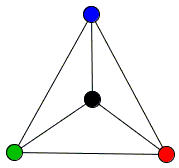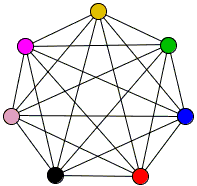Császár Polyhedron 1
We are concerned here with a curious phenomenon of a polyhedron with no diagonals. Tetrahedron provides the simplest example. Its skeleton is the complete graph K4.

Recollect the Euler polyhedral formula:
V - E + F = 2
which holds for simple polyhedrons.
Any polyhedron with no diagonals satisfies two conditions:
- E = V(V - 1)/2,
- 3F = 2E, because each of the faces is a triangle (lest there be a diagonal inside the face).
Substituting these into Euler's formula gives
However there are other polyhedrons with no diagonals. These ones could not be simple. For the figures with h holes/tunnels the Euler formula has to be modified:
V - E + F = 2 - 2h.
However, regardless of the number of holes any figure with no diagonals is bound to satisfy the two properties above, thus again substituting the two but now into the extended Euler formula we obtain
h = (V - 3)(V - 4)/12.
Now, for V = 3 and V = 4, h = 0 as it should. The next integer value for h is obtained with

The polyhedron that answers all these requirement indeed exists and was discovered in the late 1940s by Ákos Császár [Gardner, p. 139-152].
| What if applet does not run? |
Drag the mouse to rotate the prism. Use the right button to remove and put back individual faces.
(Acknowledgement: I have learned most of Java details from the implementation by Meiko Rachimow. I found the geometry of the solid at the software3d online forum.)
References
- M. Gardner, Time Travel and Other Mathematical Bewilderments, W.H.Freeman and Co., NY, 1988.
|Activities| |Contact| |Front page| |Contents| |Geometry|
Copyright © 1996-2018 Alexander Bogomolny
73575452
